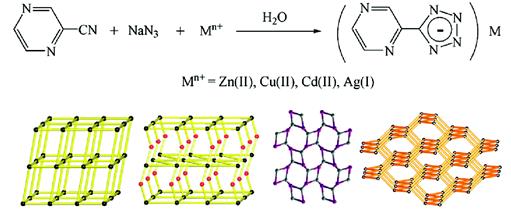
Zhen Li, Mian Li, Xiao-Ping Zhou, Tao Wu, Dan Li,* and Seik Weng Ng

Abstract: This work focuses on the investigation of the influence of metal ions and supramolecular interactions on the selfassembly of in situ generated tetrazolate coordination architectures. A series of new metal-organic complexes, [Zn(pzta)2(H2O)2](1), [Cu(pzta)2](H2O)3 (2), [Cd(pzta)2]n (3), [Ag(pzta)]n (4), and [Cd2(pzta)(OH)(SO4)]n (5) [pzta ) pyrazinyl tetrazolate], have been achieved by the in situ hydrothermal reactions of pyrazinecarbonitrile, sodium azide, and different metal ions. Complexes 1 and 2 have similar mononuclear structures bearing distinct intermolecular hydrogen-bond interactions to form two different 3D supramolecular networks based on 44-subnets. Complex 3 features a 1D crossed-shape chain structure. Complex 4 is a coordination polymer comprised of mildly undulated 2D layers with a (4.82) topological network. Complex 5 is a 3D diamondoid framework constructed by pentanuclear cadmium cluster nodes and pzta linkers. The configurations of complexes 1-5 span from mononuclear (1, 2), to one-dimensional(3) and two-dimensional (4), to three-dimensional (5), which indicates that metal ions play an essential role in the framework formation of the in situ generated tetrazolate architectures. Furthermore, complexes 1, 3, and 5 exhibit strong blue photoluminescence in similar energy regions.
文章链接:![]() cg0702333.pdf
cg0702333.pdf




